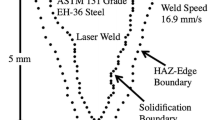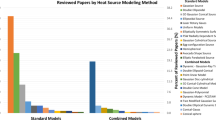Abstract
A general approach for inverse thermal analysis of heat deposition processes is parametric modeling of such processes using effective or equivalent source distributions (ESDs). ESDs can be adjusted conveniently for calculation of temperature fields, which are constrained according to boundary and temperature constraint conditions. This study applies properties of ESDs useful for parametric modeling of heat deposition processes. Inverse thermal analysis of a friction stir weld is presented, which is prototypical of processes tending to be complex with respect to energy deposition morphology. This analysis demonstrates properties of ESDs providing relatively optimal parametric modeling of energy deposition processes.















Similar content being viewed by others
References
M.N. Ozisik and H.R.B. Orlande, Inverse Heat Transfer, Fundamentals and Applications, Taylor and Francis, New York, 2000
K. Kurpisz and A.J. Nowak, Inverse Thermal Problems, Computational Mechanics Publications, Boston, 1995
O.M. Alifanov, Inverse Heat Transfer Problems, Springer, Berlin, 1994
J.V. Beck, B. Blackwell, and C.R. St, Clair, Inverse Heat Conduction: Ill-Posed Problems, Wiley Interscience, New York, 1985
J.V. Beck, Inverse Problems in Heat Transfer with Application to Solidification and Welding, Modeling of Casting, Welding and Advanced Solidification Processes, Vol The, Minerals , M. Rappaz, M.R. Ozgu, and K.W. Mahin, Ed., Metals and Materials Society, Pittsburgh, 1991, p 427–437
J.V. Beck, Inverse Problems in Heat Transfer, Mathematics of Heat Transfer, G.E. Tupholme and A.S. Wood, Ed., Clarendon Press, Oxford, 1998, p 13–24
S.G. Lambrakos, Parametric Modeling of Welding Processes Using Numerical-Analytical Basis Functions and Equivalent Source Distributions, J. Mater. Eng. Perform., 2016, 25(4), p 1360–1375
S.G. Lambrakos, Inverse Thermal Analysis of Welds Using Multiple Constraints and Relaxed Parameter Optimization, J. Mater. Eng. Perform., 2015, 24(8), p 2925–2936
S.G. Lambrakos, Inverse Thermal Analysis of Stainless Steel Deep-Penetration Welds Using Volumetric Constraints, J. Mater. Eng. Perform., 2014, 23(6), p 2219–2232. https://doi.org/10.1007/s11665-014-1023-7
S.G. Lambrakos, A. Shabaev, and L. Huang, Inverse Thermal Analysis of a Titanium Laser Weld Using Multiple Constraint Conditions, J. Mater. Eng. Perform., 2014, https://doi.org/10.1007/s11665-014-1021-9
R.W. Fonda and S.G. Lambrakos, Analysis of Friction Stir Welds Using an Inverse-Problem Approach, Sci. Technol. Weld. Join., 2002, 7(3), p 177–181
S.G. Lambrakos, R.W. Fonda, J.O. Milewski, and J.E. Mitchell, Analysis of Friction Stir Welds Using Thermocouple Measurements, Sci. Technol. Weld. Join., 2003, 8, p 345
S.G. Lambrakos, Inverse Thermal Analysis of Ti-6AL-4V Friction Stir Welds Using Numerical-Analytical Basis Functions with Pseuda-Advection, J. Mater. Eng. Perform., 2018, https://doi.org/10.1007/s11665-018-3377-8
J.N. Wolk, Microstructural Evolution in Friction Stir Welding of Ti 5111, Doctoral Thesis, University of Maryland, College Park, 2010
D. Rosenthal, The Theory of Moving Sources of Heat and Its Application to metal treatments, Trans. ASME, 1946, 68, p 849–866
R.O. Myhr and O. Grong, Dimensionless Maps for Heat Flow Analysis in Fusion Welding, Acta Metall. Mater., 1990, 38, p 449–460
C.G. Prosgolitis, S.G. Lambrakos, and A.D. Zervaki, Phase-Field Modeling of Nugget Zone for a AZ31-Mg-Alloy Friction Stir Weld, J. Mater. Eng. Perform., 2018, 27(10), p 5102–5113
Acknowledgments
This work was supported by a Naval Research Laboratory (NRL) internal core program.
Author information
Authors and Affiliations
Corresponding author
Additional information
Publisher's Note
Springer Nature remains neutral with regard to jurisdictional claims in published maps and institutional affiliations.
Rights and permissions
About this article
Cite this article
Lambrakos, S.G. Properties of Equivalent Source Distributions Useful for Inverse Thermal Analysis. J. of Materi Eng and Perform 28, 4894–4902 (2019). https://doi.org/10.1007/s11665-019-04241-6
Received:
Revised:
Published:
Issue Date:
DOI: https://doi.org/10.1007/s11665-019-04241-6




